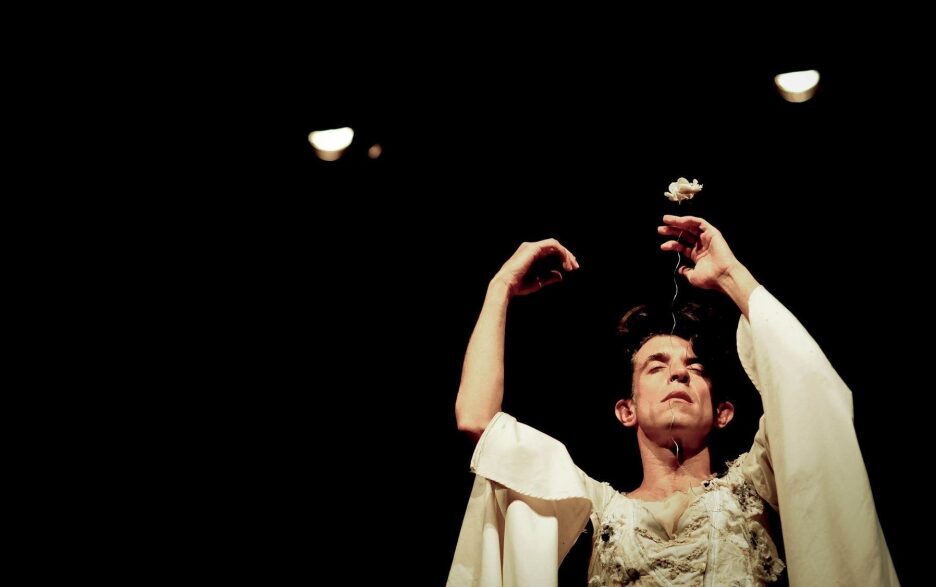Costumes | Carlota Lagido
Light design and technical direction | Frank Laubenheimer
Music | Jordi Savall
Photography | Susana Paiva
Production | EIRA
Duration 45 min
Age rating >12
Francisco Camacho
Francisco Camacho is a choreographer, dancer, founding member and artistic director of EIRA.
He is internationally recognized as one of the protagonists of the contemporary dance movement that began in Portugal at the end of the 1980s, performing in Europe, America, Africa and Asia, with works that are a reference in Portuguese dance. Among others, he created the multiple well aclaimed solo shows. Since 2017, he has been developing the "Sentimental Journey" project, creating shows inspired by and presented in Loulé, Montemor-o-Velho, S. Vicente de Fora (Lisbon), Setúbal, Braga and Nuoro (Italy).
He was awarded the Casa da Imprensa's Bordalo Prize for Dance (1995 and 1997) and the Calouste Gulbenkian Foundation's ACARTE/Maria Madalena de Azeredo Perdigão Prize (1994/95), as well as a Special Mention of the same Prize (1992/93). He has also co-authored shows with Mónica Lapa, Vera Mantero, Carlota Lagido, Vera Mota and Sílvia Real, as well as co-creations with theater directors Fernanda Lapa and Miguel Abreu. He created choreographic interventions for a work by Pedro Cabrita Reis at the Museum of Contemporary Art in Bonn and for the Francis Bacon exhibition at the Serralves Museum, as well as developing projects for non-conventional spaces such as 'Performers Anónimos' and 'Danças Privadas'. After being a trainee at the Gulbenkian Ballet (1984/86), he danced in choreographies by Paula Massano, a pioneer choreographer of Portuguese contemporary dance, and by Creach/Koester, Meg Stuart, Alain Platel, Carlota Lagido, Miguel Moreira and Filipa Francisco, among others. He regularly collaborates with Meg Stuart, particularly as the lead in "BLESSED", which has already been performed over a hundred times. He has also taken part as an actor in productions by Lúcia Sigalho and Tonan Quito. He studied dance and theater in Portugal (Companhia Nacional de Bailado and Ballet Gulbenkian) and in New York (Merce Cunningham Dance Studio, Movement Research, Susan Klein School and Lee Strasberg Theatre Institute), and had additional training in voice, scriptwriting and creative writing. He teaches regularly in Portugal and abroad.
Frank Laubenheimer (Technical Director) lives in Nuremberg, Germany. Worked for over 15 years in the light and sound design. Since 2006, collaborates regularly in the design of projects in various dance
and theater companies and choreographers such as Meg Stuart, Deja Donné, Daniela Kurz, Unterwegstheater and Francisco Camacho.
"Our Lady of Flowers" | NOSSA SENHORA DAS FLORES
Premiered in 1993,
"Our Lady of Flowers" still
retains all the qualities
that made this show one of the landmarks of Portuguese
contemporary dance.
With its presentation in more than thirty theaters and
festivals in Europe, America and Africa, Francisco Camacho has also established his importance as a
creator and performer on the international circuit.
In this solo, which shares the title with Jean Genet’s
novel, but only the title, Francisco Camacho presents us with a body in movement that
"fragments what is supposed to be united, revealing the heterogeneity of what we supposed to be
consistent"(Foucault). For Camacho, the body on stage appears like a nervous system shaken by a fragmented
and violent past, which is neither dead nor far away in time. A past inscribed in our bodies that tries
to survive its own absurdities and contradictions.
In Our Lady of Flowers, Camacho unfolds the history of
the body in pain and pleasure. As dramaturge and curator André Lepecki wrote, Our Lady
of Flowers is “a choreography of convulsion, of obsession, of the failure of physiological systems,
of the body in collapse, of dance in absolute sensual pleasure in what supposes its invocation of
spirits, of irony, of humor, of sensuality and obscenity.”
BACK

